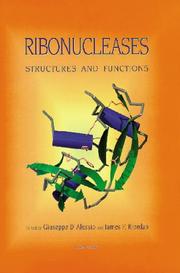| Listing 1 - 10 of 16 | << page >> |
Sort by
|
Book
Abstract | Keywords | Export | Availability | Bookmark
 Loading...
Loading...Choose an application
- Reference Manager
- EndNote
- RefWorks (Direct export to RefWorks)

ISBN: 1281033537 9786611033538 0080540597 0125889453 Year: 1997 Publisher: San Diego : Academic Press,
Abstract | Keywords | Export | Availability | Bookmark
 Loading...
Loading...Choose an application
- Reference Manager
- EndNote
- RefWorks (Direct export to RefWorks)
Pancreatic ribonuclease, the focus of highly productive scientific research for more than half a century and the only enzyme to be the basis of four Nobel prizes, has recently undergone a resurgence in popularity for the recognition of an extended ribonuclease superfamily with functions ranging from tumour growth and inhibition to self-recognition and neurotoxicity. This volume highlights the functional diversity of ribonucleases and reveals the emerging research opportunities provided by these enzymes.* Never before has discussion of the entire family of ribonucleases and related
Nucleoproteins. --- Ribonucleases. --- Ribonucleases--Structure-activity relationships. --- RNA. --- Ribonucleases --- Structure-Activity Relationship --- Esterases --- Pharmacological Phenomena --- Biochemical Phenomena --- Hydrolases --- Physiological Phenomena --- Chemical Phenomena --- Phenomena and Processes --- Enzymes --- Enzymes and Coenzymes --- Chemicals and Drugs --- Animal Biochemistry --- Human Anatomy & Physiology --- Health & Biological Sciences --- Structure-activity relationships --- Nucleases. --- Structure-activity relationships. --- RNases --- Nucleases
Book
ISSN: 00766879 ISBN: 9780123743787 0123743788 9786612287312 1282287311 0080922074 Year: 2008 Volume: 448 Publisher: San Diego, Calif. ; London : Academic,
Abstract | Keywords | Export | Availability | Bookmark
 Loading...
Loading...Choose an application
- Reference Manager
- EndNote
- RefWorks (Direct export to RefWorks)
Specific complexes of protein and RNA carry out many essential biological functions, including RNA processing, RNA turnover, RNA folding, as well as the translation of genetic information from mRNA into protein sequences. Messenger RNA (mRNA) decay is now emerging as an important control point and a major contributor to gene expression. Continuing identification of the protein factors and cofactors, and mRNA instability elements responsible for mRNA decay allow researchers to build a comprehensive picture of the highly orchestrated processes involved in mRNA decay and its regulation.
Messenger RNA. --- Genetic regulation. --- Eukaryotic cells. --- Nucleases. --- ARN messager --- Régulation génétique --- Cellules eucaryotes --- Régulation génétique --- Eucaryotic cells --- Gene expression --- Gene expression regulation --- Gene regulation --- Informational RNA --- Messenger ribonucleic acid --- mRNA --- Protein transcript --- Protein transcripts --- Template RNA --- Regulation --- Esterases --- Cells --- Protista --- Biosynthesis --- Cellular control mechanisms --- Molecular genetics --- RNA

ISBN: 1281025917 9786611025915 0080542557 0122332105 9780122332104 9780080542553 9781281025913 Year: 1998 Publisher: San Diego, CA : Academic Press,
Abstract | Keywords | Export | Availability | Bookmark
 Loading...
Loading...Choose an application
- Reference Manager
- EndNote
- RefWorks (Direct export to RefWorks)
The Many Faces of RNA is the subject for the eighth SmithKline Beecham Pharmaceuticals Research Symposia. It highlights a rapidly developing area of scientific investigation. The style and format are deliberately designed to promote in-depth presentations and discussions and to facilitate the forging of collaborations between academic and industrial partners.This symposium focuses on several of the many fundamental, advancing strategies for exploring RNA and its functions. It emphasizes the interplay between biology, chemistry, genomics, and molecular biology which is leading to exc
RNA --- Ribonucleases --- RNA-protein interactions --- Antibiotics --- Therapeutic use --- Physiological effect --- Anti-infective agents --- Microbial metabolites --- Allelopathic agents --- Antibiosis --- Pharmaceutical microbiology --- Phytoncides --- Interactions, RNA-protein --- Protein-RNA interactions --- RNA-protein binding --- Protein binding --- RNases --- Nucleases --- Ribonucleic acid --- Ribose nucleic acid --- Nucleic acids --- Ribose

ISBN: 1280412968 9786610412969 3540294740 3540251065 3540852352 Year: 2005 Publisher: Berlin ; New York : Springer,
Abstract | Keywords | Export | Availability | Bookmark
 Loading...
Loading...Choose an application
- Reference Manager
- EndNote
- RefWorks (Direct export to RefWorks)
This book provides the first and only comprehensive description and detailed summary of the genetics, structure, function, mechanisms of action, evolution and engineering of homing endonucleases and inteins. These two unique protein superfamilies, which are tied together through their frequent fusion and coevolution, have generated considerable excitement for their fundamental, structural, and functional properties, their evolution as parasitic elements, and their widespread applications as gene targeting agents and as instruments for the generation of modified proteins and novel protein combinations.
Endonucleases. --- Protein engineering. --- Engineering, Protein --- Protein design --- Proteins --- Biochemical engineering --- Genetic engineering --- Nucleases --- Design --- Biochemistry. --- Cytology. --- Biochemical engineering. --- Genetic engineering. --- Biochemistry, general. --- Cell Biology. --- Biochemical Engineering. --- Genetic Engineering. --- Designed genetic change --- Engineering, Genetic --- Gene splicing --- Genetic intervention --- Genetic surgery --- Genetic recombination --- Biotechnology --- Transgenic organisms --- Bio-process engineering --- Bioprocess engineering --- Biochemistry --- Chemical engineering --- Cell biology --- Cellular biology --- Biology --- Cells --- Cytologists --- Biological chemistry --- Chemical composition of organisms --- Organisms --- Physiological chemistry --- Chemistry --- Medical sciences --- Composition --- Cell biology.
Book
ISBN: 1872748007 Year: 1991 Publisher: Oxford Blackwell
Abstract | Keywords | Export | Availability | Bookmark
 Loading...
Loading...Choose an application
- Reference Manager
- EndNote
- RefWorks (Direct export to RefWorks)
Molecular biology --- Biologie moléculaire --- Laboratoire --- laboratories --- Enzymes --- Bacteria --- Bacteriophages --- Plasmide --- plasmids --- Clonage --- cloning --- genomes --- genes --- Électrophorèse --- Electrophoresis --- Hybridation --- Hybridization --- Centrifugation --- Centrifuging --- Sécurité --- safety --- Méthylation --- Methylation --- ADN --- DNA --- Nucléase --- Nucleases --- Estérase --- Esterases --- GENETIC TECHNIQUES --- MICROBIOLOGICAL TECHNIQUES --- tables --- outlines --- tables. --- outlines. --- Genetic techniques --- Microbiological techniques --- Tables. --- Outlines. --- Biologie moléculaire --- Centrifuging. --- Methylation. --- DNA. --- Restriction --- Arn polymerase --- Topoisomerase --- BACTERIA --- VIRUS, BACTERIAL --- RADIOELEMENTS --- MOLECULAR CLONING --- GENES --- ENZYMES --- ELECTROPHORESIS --- CENTRIFUGATION --- SAFETY --- BIOLOGICAL STUDIES
Book
ISBN: 1441911413 1461425735 9786612831577 1282831577 1441911421 Year: 2010 Publisher: New York : Springer Science,
Abstract | Keywords | Export | Availability | Bookmark
 Loading...
Loading...Choose an application
- Reference Manager
- EndNote
- RefWorks (Direct export to RefWorks)
Ribonuclease P (RNaseP), a ribonucleoprotein, is an essential tRNA processing enzyme found in all living organisms. Since its discovery almost 40 years ago, research on RNase P has led to the discovery of the catalytic properties of RNA, and of the only known, naturally occurring RNA enzymes, RNase P catalytic RNA. The description of the catalytic properties of RNA has provided fundamental insight into the RNA world and these catalytic properties are being harnessed as therapeutic and prevention strategies for acquired and inherited diseases. Ribonuclease P is the first book to provide a comprehensive collection covering all aspects of current research on RNase P. The topics include kinetic and structural analysis, mechanism of catalysis, and its regulation and biogenesis in prokaryotes, eukaryotes, and organelles. Furthermore, research progresses on developing RNase P as a potential drug target for antimicrobial development and as a gene-targeting tool for anti-infective and anticancer therapy are also included. This book should be of general interests to molecular biologists and biochemists in both the academic section and pharmaceutical industry.
Gene silencing. --- Ribonucleases. --- RNA. --- Small interfering RNA -- Therapeutic use. --- RNA --- Ribonucleases --- Ribonucleoproteins --- Endoribonucleases --- RNA, Catalytic --- Nucleic Acids --- Ribonuclease P --- Enzymes --- RNA-Binding Proteins --- Nucleic Acids, Nucleotides, and Nucleosides --- Nucleoproteins --- Carrier Proteins --- Chemicals and Drugs --- Enzymes and Coenzymes --- Esterases --- Proteins --- Hydrolases --- Amino Acids, Peptides, and Proteins --- Human Anatomy & Physiology --- Chemistry --- Biochemistry --- Animal Biochemistry --- Physical Sciences & Mathematics --- Health & Biological Sciences --- Proteins. --- Proteids --- RNases --- Life sciences. --- Proteomics. --- Life Sciences. --- Molecular biology --- Biosciences --- Sciences, Life --- Science --- Biomolecules --- Polypeptides --- Proteomics --- Nucleases
Book
Year: 2021 Publisher: Basel, Switzerland MDPI - Multidisciplinary Digital Publishing Institute
Abstract | Keywords | Export | Availability | Bookmark
 Loading...
Loading...Choose an application
- Reference Manager
- EndNote
- RefWorks (Direct export to RefWorks)
Mitochondria play an increasingly central role in the context of cellular physiology. These organelles possess their own genome (mtDNA), which is functionally coordinated with the nuclear genome. Mitochondrial gene expression is mediated by molecular processes (replication, transcription, translation, and assembly of respiratory chain complexes) that all take place within the mitochondria. Several aspects of mtDNA expression have already been well characterized, but many more either are under debate or have yet to be discovered. Understanding the molecular processes occurring in mitochondria also has clinical relevance. Dysfunctions affecting these important metabolic ‘hubs’ are associated with a whole range of severe disorders, known as mitochondrial diseases. In recent years, significant progress has been made to understand the pathogenic mechanisms underlying mitochondrial dysfunction; however, to date, mitochondrial diseases are complex genetic disorders without any effective therapy. Current therapeutic strategies and clinical trials are aimed at mitigating clinical manifestations and slowing the disease progression to improve the quality of life of patients. The goal of the Special Issue ‘Mitochondria: from Physiology to Pathology’ published in Life (ISSN: 2075-1729) was to collect research and review articles covering the physiological and pathological aspects related to mtDNA maintenance and gene expression, mitochondrial biogenesis, protein import, organelle metabolism, and quality control.
Research & information: general --- atherosclerosis --- carotid intima-media thickness --- mitochondrial mutations --- cardiovascular risk factors --- mitochondria --- mtDNA --- cristae --- mitochondrial fission --- mitochondrial fusion --- mitochondrial diseas --- mitochondrial dynamics --- mitoenergetics --- mitosteroidogenesis --- LH --- cAMP --- Leydig cell --- mitochondrial DNA segregation --- heteroplasmy --- selective elimination --- mitophagy --- mitochondrial engineered nucleases --- kinases --- phosphorylation --- disease --- PINK1 --- Parkinson’s disease --- mitochondria homeostasis --- Cterm --- MELAS --- transmitochondrial cybrids --- aminoacyl-tRNA synthetases --- LARS2 --- mitochondrial disease --- therapeutic peptides --- FAD synthase --- FAD1 --- mitochondria localization --- Saccharomyces cerevisiae --- mRNA --- mitochondrial localization motif --- n/a --- Parkinson's disease
Book
ISBN: 9048182271 140209955X 9786612363719 1282363719 1402099568 Year: 2009 Publisher: Dordrecht ; London : Springer,
Abstract | Keywords | Export | Availability | Bookmark
 Loading...
Loading...Choose an application
- Reference Manager
- EndNote
- RefWorks (Direct export to RefWorks)
Multi-scale Quantum Models for Biocatalysis: Modern Techniques and Applications explores various molecular modelling techniques and their applications in providing an understanding of the detailed mechanisms at play during biocatalysis in enzyme and ribozyme systems. These areas are reviewed by an international team of experts in theoretical, computational chemistry, and biophysics. This book has three sections that group together different aspects of multi-scale quantum simulations. The first section consists of four chapters that describe strategies for multi-scale quantum models and present an overview of the current state-of-the-art molecular modelling methodologies most relevant to handling these complex systems with quantum mechanics and molecular simulation. With five chapters, the second section mainly focuses on the current efforts to improve the accuracy of quantum calculations using simplified empirical model forms. The last section consists of five chapters focused on the applications of important biological systems using multi-scale quantum models. This book presents detailed reviews concerning the development of various techniques, including ab initio molecular dynamics, density functional theory, combined QM/MM methods, solvation models, force field methods, and free-energy estimation techniques, as well as successful applications of multi-scale methods in the biocatalysis systems including several protein enzymes and ribozymes. Multi-scale Quantum Models for Biocatalysis: Modern Techniques and Applications is an excellent source of information for research professionals involved in computational chemistry and physics, material science, nanotechnology, rational drug design and molecular biology. It is also likely to be of interest to graduate and undergraduate students exposed to these research areas.
Enzymes --Biotechnology. --- Molecules --Models. --- Enzymes --- Biocatalysis --- Molecules --- Animal Biochemistry --- Physical & Theoretical Chemistry --- Chemistry --- Human Anatomy & Physiology --- Physical Sciences & Mathematics --- Health & Biological Sciences --- Biotechnology --- Models --- Enzymology. --- Catalytic RNA. --- Quantum chemistry. --- Mathematical models. --- Biophysics. --- Biological physics --- Models, Mathematical --- Chemistry, Quantum --- Ribonucleic acid enzymes --- Ribozymes --- RNA enzymes --- Chemistry. --- Chemistry, Physical and theoretical. --- Catalysis. --- Materials science. --- Nanotechnology. --- Theoretical and Computational Chemistry. --- Materials Science, general. --- Biology --- Medical sciences --- Physics --- Non-coding RNA --- Nucleases --- Biochemistry --- Simulation methods --- Chemistry, Physical and theoretical --- Quantum theory --- Excited state chemistry --- Materials. --- Molecular technology --- Nanoscale technology --- High technology --- Engineering --- Engineering materials --- Industrial materials --- Engineering design --- Manufacturing processes --- Activation (Chemistry) --- Surface chemistry --- Physical sciences --- Materials --- Material science --- Chemistry, Theoretical --- Physical chemistry --- Theoretical chemistry
Book
ISBN: 3642210775 3642210783 Year: 2011 Publisher: Berlin : Springer,
Abstract | Keywords | Export | Availability | Bookmark
 Loading...
Loading...Choose an application
- Reference Manager
- EndNote
- RefWorks (Direct export to RefWorks)
Ribonucleases are a ubiquitous and functionally diverse group of enzymes that have a common ability to cleave RNA. Either through scission of internal phosphodiesters, or removal of nucleotides from RNA 5’ or 3’ ends, ribonucleases perform essential roles in gene expression and regulation, genome replication and maintenance, host defense, stress response, and viral strategies of infection. Ribonucleases have also served as highly informative models to understand virtually every aspect of biomolecular structure and function. The fifteen chapters in this volume are written by recognized researchers in the field, and provide in-depth analyses of the major ribonuclease families. Particular focus is given to the relation of ribonuclease structure and mechanism to biological function, as well as ribonuclease dysfunction in certain disease states. Other topics include the evolutionary genetics and functional diversification of ribonucleases, engineered ribonucleases as anti-cancer agents, the mechanisms of action of artificial ribonucleases, and ribonucleases as models to understand protein folding and stability. This volume should serve as an essential reference for a broad range of researchers and educators with interests in RNA metabolism, enzymology, and gene regulation.
Ribonucleases -- Structure-activity relationships. --- Ribonucleases. --- Ribonucleases --- Esterases --- Biological Science Disciplines --- Natural Science Disciplines --- Hydrolases --- Disciplines and Occupations --- Enzymes --- Enzymes and Coenzymes --- Chemicals and Drugs --- Physiology --- Human Anatomy & Physiology --- Chemistry --- Physical Sciences & Mathematics --- Health & Biological Sciences --- Animal Biochemistry --- Biochemistry --- RNases --- Life sciences. --- Molecular biology. --- Nucleic acids. --- Enzymology. --- Cell biology. --- Life Sciences. --- Nucleic Acid Chemistry. --- Cell Biology. --- Molecular Medicine. --- Nucleases --- Enzymes. --- Cytology. --- Medicine. --- Cell biology --- Cellular biology --- Biology --- Cells --- Cytologists --- Polynucleotides --- Biomolecules --- Clinical sciences --- Medical profession --- Human biology --- Life sciences --- Medical sciences --- Pathology --- Physicians --- Biocatalysts --- Ferments --- Soluble ferments --- Catalysts --- Proteins --- Enzymology --- Health Workforce --- Molecular biochemistry --- Molecular biophysics --- Biophysics --- Systems biology --- Biomaterials. --- Medicine --- Nucleic Acid. --- Biomedical Research. --- Research. --- Biological research --- Biomedical research
| Listing 1 - 10 of 16 | << page >> |
Sort by
|

 Search
Search Feedback
Feedback About UniCat
About UniCat  Help
Help News
News